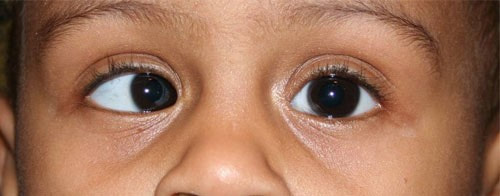Strabismus
Strabismus is the medical term for an ocular problem in which the eyes are not aligned or track together. The eyes may turn inward, outwards, upwards or downwards. 1 in 4 children in the United States has some form of strabismus.
Esotropia: Inward deviation
Infantile esotropia is a condition in which the eyes turn inwards at the time of birth. Accommodative esotropia is common in children starting between the ages of 6 months to 7 years old. In this type, when the child focuses to see clearly, the eyes turn inwards.
Exotropia: Outward deviation
One eye usually drifts outwards especially while looking into the distance. It may be intermittent and occur more frequently when the child is daydreaming or fatigued. They may also squint or close one eye in bright sunlight.
Risk Factors:
Eye motility disorders may occur in children without medical conditions, however, are more common in :
Pseudostrabismus:
Infants eyes may appear to be crossed due to the shape of the eyes, a wide flat nasal bridge, and the natural folds of skin at the inner corner of the eyelids. Children most often outgrow this condition as their face grows. It is important to be evaluated by a pediatric ophthalmologist to distinguish between true strabismus and pseudostrabismus.
Treatment:
The goal of treatment for strabismus is to straighten the eyes and restore binocular vision. In some cases eye glasses can be prescribed to your child. Other treatments may include surgery to correct the unbalanced eye muscles. Often patching may be necessary to straighten the weak eye. A combination of all of these modalities may be needed and is tailored to the special needs of your child
Call one of our offices to make an appointment if you suspect your child has a motility disorder.
Strabismus is the medical term for an ocular problem in which the eyes are not aligned or track together. The eyes may turn inward, outwards, upwards or downwards. 1 in 4 children in the United States has some form of strabismus.
Esotropia: Inward deviation
Infantile esotropia is a condition in which the eyes turn inwards at the time of birth. Accommodative esotropia is common in children starting between the ages of 6 months to 7 years old. In this type, when the child focuses to see clearly, the eyes turn inwards.
Exotropia: Outward deviation
One eye usually drifts outwards especially while looking into the distance. It may be intermittent and occur more frequently when the child is daydreaming or fatigued. They may also squint or close one eye in bright sunlight.
Risk Factors:
Eye motility disorders may occur in children without medical conditions, however, are more common in :
- Prematurity
- Cerebral Palsy
- Downs Syndrome
- Hydrocephalus
- Family History of Strabismus
Pseudostrabismus:
Infants eyes may appear to be crossed due to the shape of the eyes, a wide flat nasal bridge, and the natural folds of skin at the inner corner of the eyelids. Children most often outgrow this condition as their face grows. It is important to be evaluated by a pediatric ophthalmologist to distinguish between true strabismus and pseudostrabismus.
Treatment:
The goal of treatment for strabismus is to straighten the eyes and restore binocular vision. In some cases eye glasses can be prescribed to your child. Other treatments may include surgery to correct the unbalanced eye muscles. Often patching may be necessary to straighten the weak eye. A combination of all of these modalities may be needed and is tailored to the special needs of your child
Call one of our offices to make an appointment if you suspect your child has a motility disorder.

